- Submissions

Full Text
Strategies in Accounting and Management
Awareness and Perceptions of Sustainable Development Goals among Academia of Australian Universities
Nirosha Dilhani Kapu Arachchilage1* and Charindra Keerthipala2
1Edith Cowan University, Western Australia, Australia
2University of Ballarat, Victoria, Australia
*Corresponding author:Nirosha Dilhani Kapu Arachchilage, Edith Cowan University, Western Australia, Australia
Submission:February 26, 2024;Published: June 13, 2024
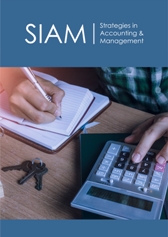
ISSN:2770-6648Volume4 Issue5
Abstract
This study was carried out to investigate the level of awareness and perceptions of Sustainable Development Goals (SDGs) among academia of Australian Universities. The SDGs also known as the Global Goals, were adopted by all United Nations Member States in 2015 as a universal call to action to end poverty, protect the planet and ensure that all people enjoy peace and prosperity by 2030. To achieve the objectives of this study, three research questions were developed. The liberal theory, professional formation theory, research engine theory as well as civic and community engagement theory were used to develop hypotheses of the study while a survey was conducted among 37 public universities for data collection. The analysis reveals that academia in Australian universities have a very positive perception about sustainable development goals though they strongly believe that most of these goals cannot be achieved by 2030 as planned. The research highlights the need for universities to rethink their sustainability strategies beyond reputational building and to have strategies in place to contribute genuinely towards eradicating economic, social, and environmental issues encountered by modern societies. This study also builds a new foundation of developing sustainability management frameworks and assessment benchmarks for Australian universities.
Keywords:Perception; Awareness; Sustainability; Academia; Development
Introduction
Sustainable development is a moral imperative Sunthonkankopang [1] and the Sustainable Development Goals (SDGs) are the UN’s blueprint for a more sustainable future for all. Their importance is emphasised by the United Nations’ General Assembly’s conclusion that the survival of societies and of the planet are at risk (UN, 2015). According to Bohringer & Jochem 2007, the SDGs focus is on three pillars of economic welfare, environmental quality and social coherence. The years 2005 to 2014 were declared the UN Decade of Education for Sustainable Development (ESD) (UNESCO, 2014) in recognition of ESD as integral to educational quality and an enabler for sustainable development (UNESCO, 2014b). ESD involves preparing “people to cope with, think critically about, and shape social, economic, political and ecological conditions characterised by change, uncertainty, risk and complexity” Stevenson, Ferreira, Davis & Evans 2012. The Stockholm Declaration of 1972 (UNEP, 1972) represents the earliest reference to the role of sustainability in higher education. Since that Declaration, there has been increasing recognition, as Cortese 2003 claimed, of the moral responsibility of higher education to contribute to a sustainable future.
Barth and Rieckmann 2016 in their study observed that universities worldwide are demonstrating interest in sustainability in their curricula. This interest from higher education reflects a “substantial rethinking” about what types of competencies and skills are required by graduates if they are to play a role in addressing sustainability-related issues and problems Ryan et al 2010. However, Holdsworth [2] argued that there was little evidence of implementation of ESD in universities and that, in Australia, it rarely figures in the curriculum. Wolff et al 2017 remarked that, in higher education, sustainability operates in principle rather than in practice. This lack of attention is due, part, to the fact that sustainability crosses many disciplines and subjects which makes it hard to integrate within the structures of higher education. Furthermore, while the recognition of and a rationale for inclusion of sustainability in higher education have been amply discussed, there is an overall lack of specifications regarding exactly how higher education should act (OECD, 2007). Azeiteiro et al 2015 concludes that higher education research on sustainability remains “at an early stage” while academics pay a little attention towards sustainable development. In this context, this study was planned to address three research questions.
Literature Review
In 1987, the Bruntland Commission published its report, Our Common Future, in an effort to link the issues of economic development and environmental stability. In doing so, this report provided the oft-cited definition of sustainable development as “development that meets the needs of the present without compromising the ability of future generations to meet their own needs” (United Nations General Assembly, 1987, p. 43). In September 2015, 17 Sustainable Development Goals (SDGs) and their associated 169 targets were agreed by 193 United Nations’ (UN) member countries to achieve sustainable development and they are to be met at the end of 2030 which refer as the Global Goal or Agenda 2030. The SDGs cover a wide range of complex social, economic, and environmental challenges and addressing them will require transformations in how societies and economies function and how we interact with our planet (UN, 2015). Education, research, innovation and leadership will be essential in helping society address these challenges. Universities, with their broad remit around the creation and dissemination of knowledge and their unique position within society, have a critical role to play in the achievement of the SDGs (SDSN, 2017). Table 1 illustrates 17 SDGs which are also sometimes referred as the Global Goals.
Table 1:The 17 SDGs.
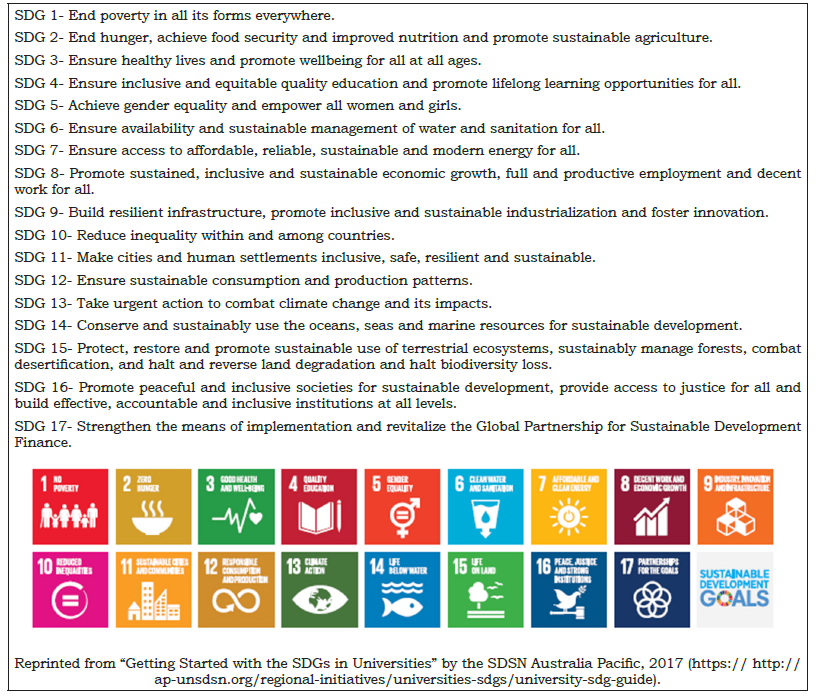
Modern universities have been in existence for more than 800 years and due to the nature of their activities and their mission, universities have an important responsibility in transforming societies, and in particular, in contributing to the development of a more sustainable humanity Barth and Rieckmann 2012. There have been competing narratives about the role of universities as higher education providers and each of these narrative has a strong contemporary resonance, and different theories propose to have a balanced approach in sustainable development, whether explicit or implicit, between the various strands Watson 2007. Liberal theory of education supports the view that universities are the communities dedicated to the learning and personal development of their members, especially students Watson 2007. As per liberal education approach to learning, it is expected to empower individuals and prepares them to deal with complexity, diversity, and change. It provides students with broad knowledge of the wider world (e.g., science, culture, and society) as well as in-depth study in a specific area of interest (AACU, 1998). Accordingly liberal education helps students to develop a sense of social responsibility including sustainability as well as strong and transferable intellectual and practical skills and a demonstrated ability to apply knowledge and skills in real-world settings Watson 2007.
The professional formation theory indicates that universities should be the sources of expertise and vocational identity in some continuing and new areas Watson, 2007. Education for the SDGs is closely aligned with the more general and well-established field of Education for Sustainable Development (ESD) and can build on its approaches and methodologies. ESD is also increasingly focussed on the SDGs and is developing resources and tools especially for learning objectives and literacy tests (SDSN, 2017). An alternative view provided by the ‘research engine’ theory is recognizing universities as the creators, testers, and sites for the evaluation and application of new knowledge Watson 2007. To achieve the SDGs, the global community will need to overcome many difficult and complex social, economic and environmental challenges, some of which will require transformations in how societies and economies function and how we interact with our planet. Universities, through their extensive research capabilities and activities, have a critical role in providing the necessary knowledge, evidence-base, solutions and innovations to underpin and support this task (SDSN, 2017).
The most relevant theory which explains the rationale of being activists of sustainable development is the civic and community engagement theory which highlights the universities’ role as important contributors to society and nations Watson 2007. The university sector has come on board with the SDGs, as an outcome of the efforts of organisations such as the Sustainable Development Solutions Network (SDSN), Future Earth, the UN Educational, Scientific and Cultural Organization (UNESCO), Principles of Responsible Management in Education (PRME), and nationally focused member-based associations – such as the Australasian Campuses Towards Sustainability (ACTS), Environmental Association for Universities and Colleges (EAUC), and Association for the Advancement of Sustainability in Higher Education (AASHE). Consequently, universities are increasingly re-thinking their role in the twenty-first century and looking to be both more responsive to societal needs and to become agents of change towards solving global challenges. As a universally agreed framework, the SDGs provide an organising structure for what this looks like for a university.
Figure 1:An overview of university contributions to the SDGs.
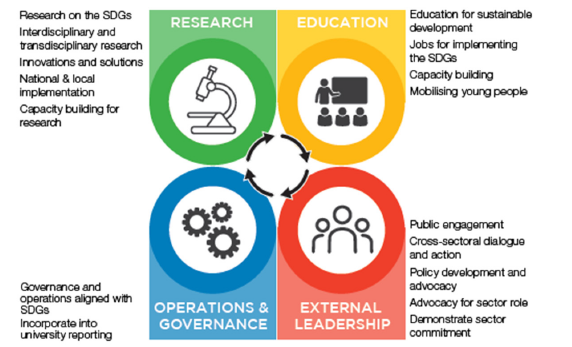
Furthermore, given the critical role universities have in ensuring the success of the SDGs, universities have a moral imperative to embody support for the SDGs as part of their social missions and core functions. Figure 1 provides an overview of the key contributions universities can make to realize SDGs. Firstly, the SDGs recognise the importance of education to sustainable development through SDG 4, which calls for providing “inclusive and equitable quality education and promoting lifelong learning opportunities for all.”
Some of the targets within this goal explicitly call for action by universities, and many others have direct relevance to learning and teaching activities within universities (SDSN 2017). Secondly, research, knowledge creation and innovation across the physical sciences, social sciences, biomedical sciences, engineering, and the humanities are fundamental for the successful implementation of all of the SDGs and thus universities can use research to achieve SDGs in a significant manner. Thirdly, all organisations will have some impact on how the SDGs are manifested within their operational sphere of influence. Depending on the nature and size of the organisation, its impacts on some and sometimes all of the SDGs can be significant. Universities are often major employers, consumers, investors, and real estate holders in societies. They oversee large communities of staff, students, and contractors. Their campuses can function like and be the size of small cities. They can create significant flows of people and goods that necessitate infrastructure investment in surrounding areas. They can also have an influence far beyond their regions through their supply chains and increasingly international reach. As a result, universities have an impact across each and every one of the SDGs, and this impact can be large on operations and governance structures.
Finally, as places devoted to knowledge creation and teaching for the benefit of society, universities have traditionally occupied a unique position in society that makes them particularly suited to provide leadership on SDG implementation Filho et al. 2017 . They are trusted by the public and are seen as neutral actors by other sectors. Many have significant prominence and influence in the public sphere. And they have expertise in research and education that is essential for building capacity and supporting policy making. While many universities have struggled to maintain this critical role under ‘rationalisation and commercialisation’ processes, the SDGs provide an opportunity to enhance this role. In this context, to successfully implement related programs in universities and to achieve SDGs it is important to have a strong level of awareness of SDGs and positive perceptions among academia as they are the lifeblood of a university, without whom the institution would not exist. Although there have been proven and successful developments in the field of higher education for sustainable development over the past 15 years or so, there are still numerous challenges that need to be overcome to achieve SDGs by 2030 Filho et al. 2015. Despite a number of ESD initiatives and universities being engaged in this process, these institutions continue to be traditional and to rely upon reductionist and mechanistic paradigms. Among these challenges, is the need for universities to improve the integration of ESD into curricula and research, and most importantly, to include it holistically into their systems. Also, stakeholders in universities sometimes face difficulties in incorporating sustainability in practice and in theory Filho et al. 2017. In this context, three research questions were examined in the study.
What is the level of awareness of Sustainable Development Goals (SDGs) among academia of Australian Universities?
What perceptions do they have about Sustainable Development Goals (SDGs) and their achievements?
What are the factors limiting the effective contribution of university academia in Australian Universities towards the actualization of Sustainable Development Goals (SDGs)?
According to Lozano et al. 2015, universities can implement sustainability concepts and translate them to practices in different domains: e.g. education and curricula, research, facilities/ campus operations, community outreach, organisational change management/institutional framework, and assessment and reporting. Indeed, diverse efforts are being made by universities worldwide to make sustainable development part of their institutional frameworks by proposing new teaching and pedagogical approaches and curricula, collaborating with other universities, encouraging campus sustainability life experiences and running ‘educating-the-educators’ programmes. Stephens et al. 2008 state that universities should be able to ‘catalyse and/ or accelerate a societal transition toward sustainability’. Progress has been noticeable specifically regarding participation processes Disterheft et al. 2015 and barriers to this intervention and to sustainability practices implementation are being addressed by higher education institutions by implementing awareness programs among academia on SDGs (e.g. Aleixo et al. 2016. Strategies and drivers for sustainability in universities implicate the local, regional and global engagement of higher education institutions in meeting the SDGs by promoting local and regional intervention, internationalisation and networking (international cooperation, students mobility and knowledge exchange), and acting always with high societal relevance and sustainability purposes (from pedagogy, research and knowledge transfer).
The opportunities offered by the SDGs to strengthen sustainable development at universities and the relevance of this topic and its international dimension require that academics of these institutions be prepared to play this relevant role actively. Moreover, the SDGs offer universities and academia a unique opportunity to reflect on the ways they operate and may encourage them to make further efforts to become more sustainable not only in respect of their operations, but also in the field of research and teaching Filho et al. 2017. Disterheft et al. 2013 highlight that assessing sustainability in higher education curricula as a critical reflection on validity issues. As per Ramos et al. 2015, unfortunately many of those efforts address only one or two of the sustainability domains at universities which continue to foster compartmentalisation, instead of a holistic approach (e.g. an approach which is inclusive and takes into account inputs and knowledge from different subjects) and a systems thinking approach. After considering extant literature, following seven themes were derived for further examination and included related statements covering these themes in the survey questionnaire for further examination.
Theme 1- University academia is aware of sustainable
development goals.
Theme 2- University academia has positive perceptions about
sustainable development goals.
Theme 3- University academia has positive perceptions about
achievement of sustainable development goals.
Theme 4- SDGs are promoted and encouraged as a topic of
research within universities.
Theme 5- Universities drive development of social and
technological innovations and solutions across SDG challenges.
Theme 6- SDGs are embedded in university curricula across
disciplines.
Theme 7- Universities actively support national and local
implementation of SDGs.
Research Methodology
A survey was conducted to investigate the level of SDG awareness and perceptions among university academia of Australian universities. The prime objectives behind this were to examine their general level of understanding about SDGs, their perception about potential achievements as well as their specific understanding about constraints which limit the effective contribution towards the actualization of SDGs.
In this regard, all the public universities of Australia were contacted via emails in 2019 from June to August. The survey invitations were sent to the concerned faculties/schools to forward the questionnaire to their academics as a soft copy. The survey questionnaire was adapted from the work of Malik et al [3], Penzenstadler [4] and Sunthonkankopang [1]. After modifying and aligning the contents of the questions with the aim of this survey, the developed questionnaire was validated for its content and face validity. Piloting of the questionnaire was done via fellow researchers, and their recommendations were amalgamated accordingly. The questionnaire validation was done through Average Congruency Percentage (ACP), and Content Validity Index (CVI). In this regard, five experts from academia were contacted. However, only three academics participated. The predefined criteria of experts included having more than five years of experience, must be involved in an SDG related project/s and have sound knowledge about sustainability development. In ACP, academics calculated the percentage of questions thought to be appropriate for them. In CVI, the content validity index for the individual item (I-CVI) was calculated. The questions were rated for their relevance. Expert 3 rated two out of 18 questions unrelated, resulting in 88.9% relevancy at their level. Expert 1 and expert 3 found all questions relevant, resulting in a 100% relevancy rate at their level. The experts’ average value of congruency percentage was 96.3%, which was considered as valid. For CV I, the same experts were requested to assess each question’s content relevance on a 4-point Likert scale. Where 1 = not related, 2 = somewhat related, 3 = related, 4 = strongly related. To decide the measures for relevance, the experts’ rating 3 or 4 was considered as related, and 1 or 2 was considered as not related. The mean I-CVI value of questions by the experts was 0.87, and the Mean Expert Proportion was calculated as 0.87. The results of ACP and I-CVI showed a high face and content validity of the questionnaire, hence certifying the quality of the instrument. The questions and their responses by the survey participants (232 participants) are described in the Table 2. A five-point Likert scale was used that consists of Extremely Aware (EA), Moderately Aware (MA), Somewhat Aware (SWA), Slightly Aware (SA), and Not at All Aware (NAA). The socio-demographic details of the participants are shown in Table 3. The demographic variables of the participants are Age, Gender, Degree/Course, Level, and Working Status.
Table 2:Survey results.
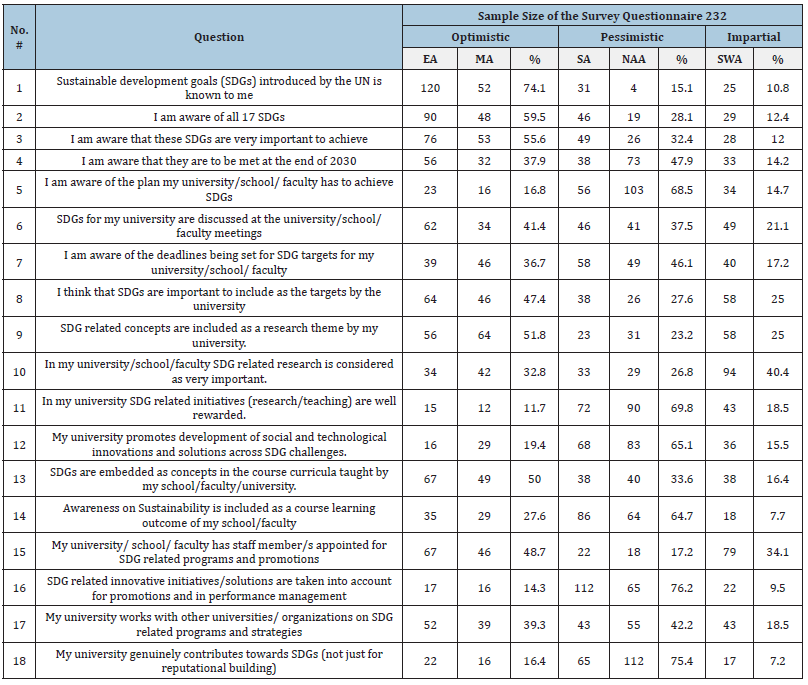
Table 3:Demographic details of survey respondents.
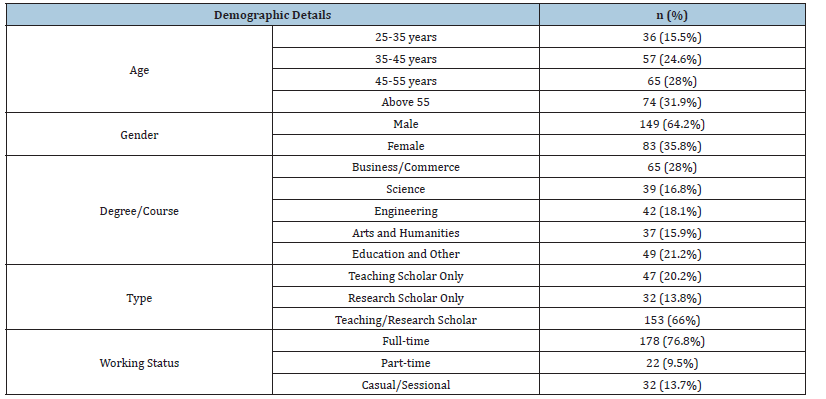
Analysis
Analysis was conducted using descriptive statistics in Excel (percentages for overall totals) and using univariate analysis of variance (ANOVA) for comparisons between degree/course of the relevant academic is involved and awareness/perceptions of SDGs among academics. Based on the percentages given in Table 2 and themes identified in the section 2 of this paper results on awareness and perceptions can be summarized as follows (Table 4). The mean value of each theme is calculated by considering percentages of optimistic, pessimistic and impartial responses given for related statements in the survey questionnaire.
Table 4:Survey results by themes.
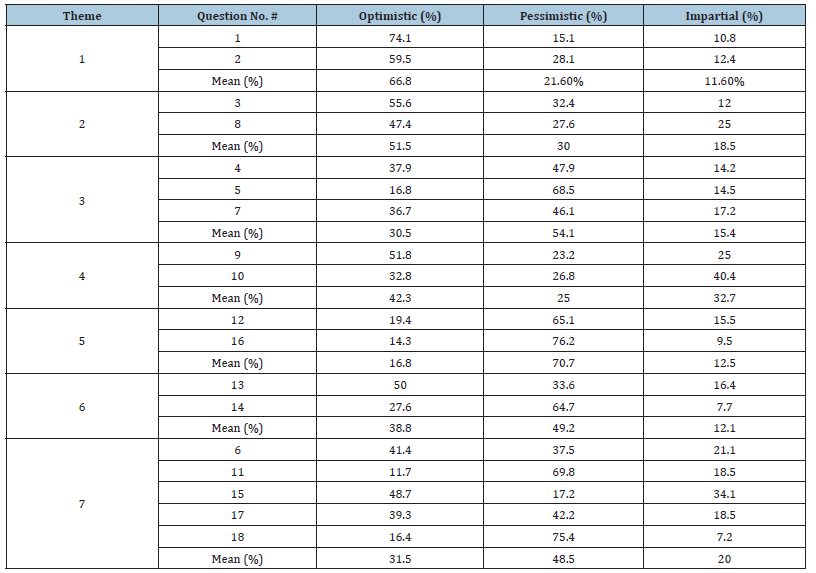
Further for each response on the Likert scale a score was assigned (EA= 5, MA = 4, SWA= 3, SA= 2, NAA= 1) and based on those assigned values ANOVA calculations were done to compare between the degree/course the relevant academic is involved in and awareness/perceptions of SDGs among academics. The demographic factor of degree/course of the relevant academic was selected for ANOVA comparisons by assuming that the results will highlight awareness and perception differences across disciplines if any.
Table 5 shows there was no significant differences between the degree/course the relevant academic is involved in and awareness of SDGs among academics.
Table 5:ANOVA results for awareness and perceptions of SDGs for degree/course (Theme 1- Awareness on SDGs).
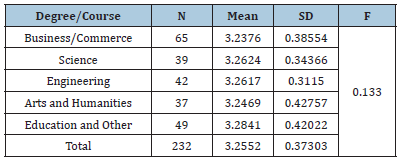
Table 6 shows there was no significant differences between the degree/course the relevant academic is involved in and positive perceptions of SDGs among academics.
Table 6:ANOVA results for awareness and perceptions of SDGs for degree/course (Theme 2- positive perceptions on SDGs).
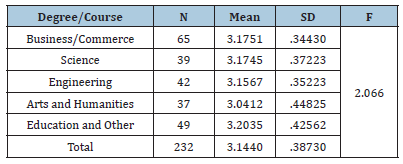
Table 7 shows there was no significant differences between the degree/course the relevant academic is involved in and positive perceptions about achievement of SDGs among academics.
Table 7:ANOVA results for awareness and perceptions of SDGs for degree/course (Theme 3- positive perceptions about achievement of SDGs).
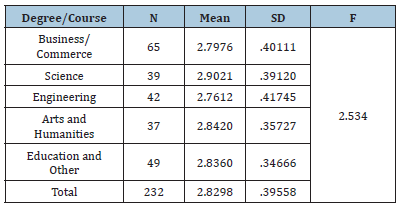
Table 8 shows there was no significant differences between the degree/course the relevant academic is involved in and awareness on SDGs in research among academics.
Table 8:ANOVA results for awareness and perceptions of SDGs for degree/course (Theme 4- Awareness on SDGs in research).
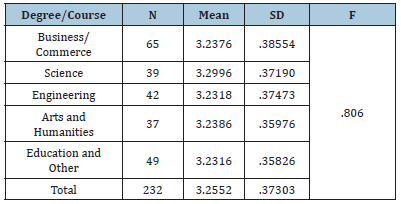
Table 9 shows there was no significant differences between the degree/course the relevant academic is involved in and awareness on social and technological innovations and solutions.
Table 9:ANOVA results for awareness and perceptions of SDGs for degree/course (Theme 5- awareness on social and technological innovations and solutions).
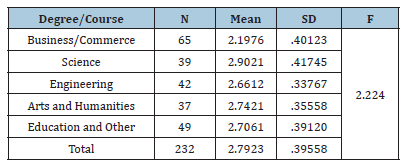
Table 10 shows there a significant difference between the degree/course the relevant academic is involved in and awareness on SDGs in university curricula.
Table 10:ANOVA results for awareness and perceptions of SDGs for degree/course (Theme 6: SDGS in university curricula).
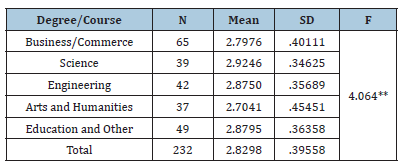
**The mean difference is significant at the .01 level.
Table 11 shows there was no significant differences between the degree/course the relevant academic is involved in and awareness on local/national implementation of SDGs by universities.
Table 11:ANOVA results for awareness and perceptions of SDGs for degree/course (Theme 7- local/national implementation of SDGs by universities).
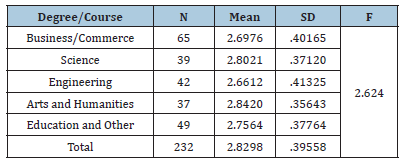
Discussion and Findings
This study examined the level of awareness and perceptions of SDGs among university academia in Australian public universities across disciplines. The survey questionnaire included statements covering 7 aspects of academic staff’s awareness of SDGs, their achievement and implementation by universities. Results showed that university academia is having a considerable level of awareness (66.8% have indicated optimistic responses) of SDGs agreed upon by the member countries of the UN. Also the results indicate that academic staff has a satisfactory level of positive perceptions about SDGs (51.5% have indicated optimistic responses). However, the comparatively lower level of awareness can be identified in relation to the potential achievement of SDGs by 2030 as required by the UN. This could be either due to insufficiency of SDG based programs in universities or due to inadequate level of information being circulated among the academic staff by university executives. Also the results indicate that staff is not having a satisfactory level of awareness on SDGs in research as well as in curricula (optimistic responses are lower than 50%). Further, the executives of universities need to pay more attention towards development of social and technological innovations and solutions across SDG challenges as the staff is having a very low level of awareness on such initiatives (70.7% have indicated pessimistic responses). Even though nearly 49% of staff is aware of local/national implementation initiatives carried out by universities more than 50% is neither aware nor partially aware of such initiatives. Also, the fact that there are no significant differences between the degree/course the relevant academic is involved in and awareness/perceptions of SDG related perspectives inform consistent level of understanding across the disciplines about SDGs and related programs within universities. However, it is interesting to see a significant level of difference between the degree/course the relevant academic is involved in and awareness on SDGs in university curricula. Especially business/commerce courses and arts and humanities programs have the highest levels of standard deviations as per Table 10 and it is vital to have rigorous programs to reflect on course learning outcomes in sustainability and SDG related fields for better awareness and understanding.
Concluding Remarks
This study has contributed to the literature on university academia’s awareness and perceptions of SDGs. In particular, this study contributes to the literature related to Australian context where research on sustainability and higher education has tended to be under-represented. The authors’ arguments are reinforced by Sunthonkankopang [1] who noted research on SDGs are predominantly carried by the US and Europe researchers. The study also focused attention on the relevance of conceptualising SDGs beyond mere level of awareness and embracing into research, curricula as well as in technical and innovative solutions. In general, higher education institutes may need to rethink overall priorities to avoid what Barnett and Coats 2005 referred to as a tendency to focus more on economic goals and on preparing students for the workplace. In terms of practice to improve Sustainability and SDG Awareness, Attitudes and Actions (SAAA), Kalsoom and Khanam 2017 argued that sustainability education requires transformative practices that lead to changes in and questioning of assumptions, cognition and values. This research therefore highlights the need for universities to rethink about their sustainability strategies beyond reputational building and to have strategies in place to contribute genuinely towards eradicating of economic, social and environmental issues encountered by modern societies. Accordingly, this study also builds a new foundation of developing sustainability management frameworks and assessment benchmarks for Australian universities [5-17].
However, results of this study should be interpreted in relation to the limitations of the study. One of these limitations is that the survey identified participants’ levels of SDG awareness without identifying why they had these levels. Future studies might include, following analysis of survey results, interviews or focus groups to gain insights into factors that influence SDG awareness. A further limitation of the study is that it was not possible to identify those non-university related factors (e.g., exposure to sustainability issues through social media) that might have influenced participants SDG awareness. This study was also limited to self-report measures. As noted previously, participants may have provided responses that reflect a social-desirability bias, i.e., they want to ‘look good’. The study was also conducted only in Australia and at one time and therefore contextual factors and longitudinal studies may bring different results in other countries. Thus, it is up to the readers to generalise these results to their context.
References
- Sunthonkankopang W, Murphy E (2019) Sustainability awareness, attitudes and actions: A survey of pre-service teachers, Issues in Educational Research 29(2): 562-582.
- Wiedmann TO, Schandl H, Lenzen M, Moran D, Suh S, et al. (2015) The material footprint of nations. Proc Natl Acad Sci USA 112(20): 6271- 6276.
- Malik MN, Khan HH, Subhan F (2017) Sustainable design of mobile icons: Investigating effect on mentally retarded users. J Med Imaging Health Inform 7(6): 1419-1428.
- Penzenstadler B (2013) Towards a definition of sustainability in and for software engineering. In Proceedings of the 28th Annual ACM Symposium on Applied Computing, Coimbra, Portugal, pp. 18-22.
- Bue MCL, Klasen S (2013) Identifying synergies and complementarities between MDGs: Results from cluster analysis. Social Indicators Research 113(2): 647-670.
- Chetty R, Stepner M, Abraham S, et al. (2014) The association between income and life expectancy in the United States, 2001–2014. JAMA 315(16): 1750-1766.
- Costanza R, Fioramonti L, Kubiszewski I (2016) The UN sustainable development goals and the dynamics of well‐being. Frontiers in Ecology and the Environment 14(2): 59-59.
- Dick M, Drangmeister J, Kern E, Naumann S (2013) Green software engineering with agile methods. In Proceedings of the 2nd International Workshop on Green and Sustainable Software (GREENS), San Francisco, CA, USA, pp. 78-85.
- (2015) Global Reporting Institute (GRI), United Nations Global Compact (UNGC) & World Business Council for Sustainable Development (WBCSD), The SDG Compass: The guide for business action on the SDGs.
- Kanuri C, Revi A, Espey J, Kuhle H (2016) Getting started with the SDGs in cities: A guide for stakeholders, Sustainable Development Solutions Network.
- Malekpour S, Caball R, Brown RR, Georges N, Jasieniak J (2017) Food-energy-water nexus: Ideas for Monash Clayton Campus, Monash University, Melbourne, Australia.
- Malik MN, Khan HH, Chofreh AG, Gony FA, Clemes JJ, Alotaibi Y (2019) Investigating students’ sustainability awareness and the curriculum of technology education in Pakistan. Sustainability 11(9): 1-18.
- Osborn D, Cutter A, Ullah F (2015) Universal sustainable development goals: Understanding the transformational challenge for developed countries: Report of study by stakeholder forum.
- SDSN Australia Pacific (2017) Getting Started with the SDGs in Universities.
- Saunila M, Ukko J, Rantala T (2018) Sustainability as a driver of green innovation investment and exploitation. J Clean Prod 179: 631-641.
- William B (2016) The role of libraries towards national development: Lesson from other countries.
- Yoon DK (2012) Assessment of social vulnerability to natural disasters: A comparative study. Natural Hazards 63(2): 823- 843.
© 2024 Nirosha Dilhani Kapu Arachchilage. This is an open access article distributed under the terms of the Creative Commons Attribution License , which permits unrestricted use, distribution, and build upon your work non-commercially.
 a Creative Commons Attribution 4.0 International License. Based on a work at www.crimsonpublishers.com.
Best viewed in
a Creative Commons Attribution 4.0 International License. Based on a work at www.crimsonpublishers.com.
Best viewed in 







.jpg)






























 Editorial Board Registrations
Editorial Board Registrations Submit your Article
Submit your Article Refer a Friend
Refer a Friend Advertise With Us
Advertise With Us
.jpg)






.jpg)














.bmp)
.jpg)
.png)
.jpg)










.jpg)






.png)

.png)



.png)






